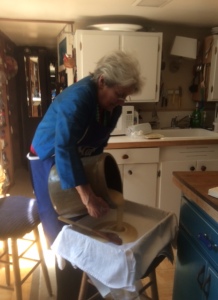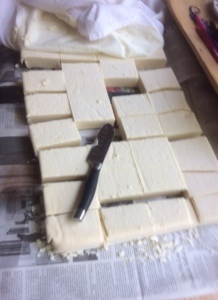 I’ve spent the last 48 hours making soap: readying scale, pot, crock, wooden spoon, box lined with a dish towel, weighing the accumulated fat from the last year. When the fat is melted, you add it to a lye-and-water mixture and stir. You go on stirring (on and off during the middle of the day); pouring, when it looks about ready, into the linen-lined box, the now honey-colored, thick mixture. It all involved maybe 45 minutes of actual activity/work.
I’ve spent the last 48 hours making soap: readying scale, pot, crock, wooden spoon, box lined with a dish towel, weighing the accumulated fat from the last year. When the fat is melted, you add it to a lye-and-water mixture and stir. You go on stirring (on and off during the middle of the day); pouring, when it looks about ready, into the linen-lined box, the now honey-colored, thick mixture. It all involved maybe 45 minutes of actual activity/work.
Then the next day you cut it. And the day after that you unmold it, and stack it so the air can continue to reach it.
The start is a little tricky: when you put a full container of lye (from the “clearing drains” section of your hardware store) into the quart of water you’ve put into the bottom of a ceramic crock, you cough, duck away, even though you’ve got windows open, oven fan on. Maybe this is why I reneged on my promise to our young neighbor girls to let them know when I was going to make soap. (Please forgive me, Sophie and Caroline. Maybe, now that you know what it involves, you will be able to help take it over as I become less able.)
 Every year it varies, and I don’t know why. One year, it was ready to pour in half an hour, and I was taken by surprise. This year, I did puzzles, Tom and I ate lunch, a half day passed before it was ready. There’s a chemical reaction happening, and a cooling process, but what the relationship is between these and the nature of the six pounds of fat you’ve started with, I don’t know. Over the year you’ve collected from roasts of all kinds, bacon fryings, etc. some of which included some oil, this fat, boiling it up, letting it rise and harden, skimming off the sludge, freezing it in cakes so it wouldn’t become rancid, wondering why your freezer was becoming so crowded.
Every year it varies, and I don’t know why. One year, it was ready to pour in half an hour, and I was taken by surprise. This year, I did puzzles, Tom and I ate lunch, a half day passed before it was ready. There’s a chemical reaction happening, and a cooling process, but what the relationship is between these and the nature of the six pounds of fat you’ve started with, I don’t know. Over the year you’ve collected from roasts of all kinds, bacon fryings, etc. some of which included some oil, this fat, boiling it up, letting it rise and harden, skimming off the sludge, freezing it in cakes so it wouldn’t become rancid, wondering why your freezer was becoming so crowded.
I’ve thought a lot this last few days about why this “labor” is so satisfying. It makes a product that is usable, makes good presents. It avoids waste, encourages your septic tank by not over-loading it. But I think something about its slow and gestational process is what makes it so important, satisfying to me: maybe an antidote to speed and endless flexibility, a “stay against confusion,” and maybe too some joining to generations of women who came before us.
To get their lye, they used water that had been poured through a bin of ashes from their wood- stove. And they probably got at least as much variation year to year as we do.
 This last is the last two bars of last year’s soap. It’s unscented, very mild. One batch even floated.
This last is the last two bars of last year’s soap. It’s unscented, very mild. One batch even floated.
